An Active View of Emerging Market Small Caps

Many investors overlook small-capitalization stocks, and even more so in emerging markets. But perhaps more investors should take a closer look at the smaller end of the market spectrum, according to the Franklin Templeton Emerging Markets Equity team. Manraj Sekhon, Chetan Sehgal, Vikas Chiranewal and Krzysztof Musialik explore the opportunities for investors in this space, and why they believe active managers can add value.
Addressing Some Common Misconceptions Surrounding EM Small Caps
We believe the emerging market (EM) small-cap space is an attractive proposition in the current investment climate as a multitude of mispriced securities, market inefficiencies and a paucity of research provide considerable opportunities for seeking alpha.1 However, there are some common misconceptions regarding the asset class which, in our view, conceal key strengths that an active manager could potentially benefit from.
It Is Not a “Niche” Asset Class
Despite broad perceptions, in our view, EM small caps are far from being a niche investment. The asset class represents more than 24,870 companies with an aggregate market capitalization of more than US$10.2 trillion and daily turnover of over US$70 billion.2 As the chart below demonstrates, aggregate liquidity within the EM small-cap space is comparable to that of EM large caps.
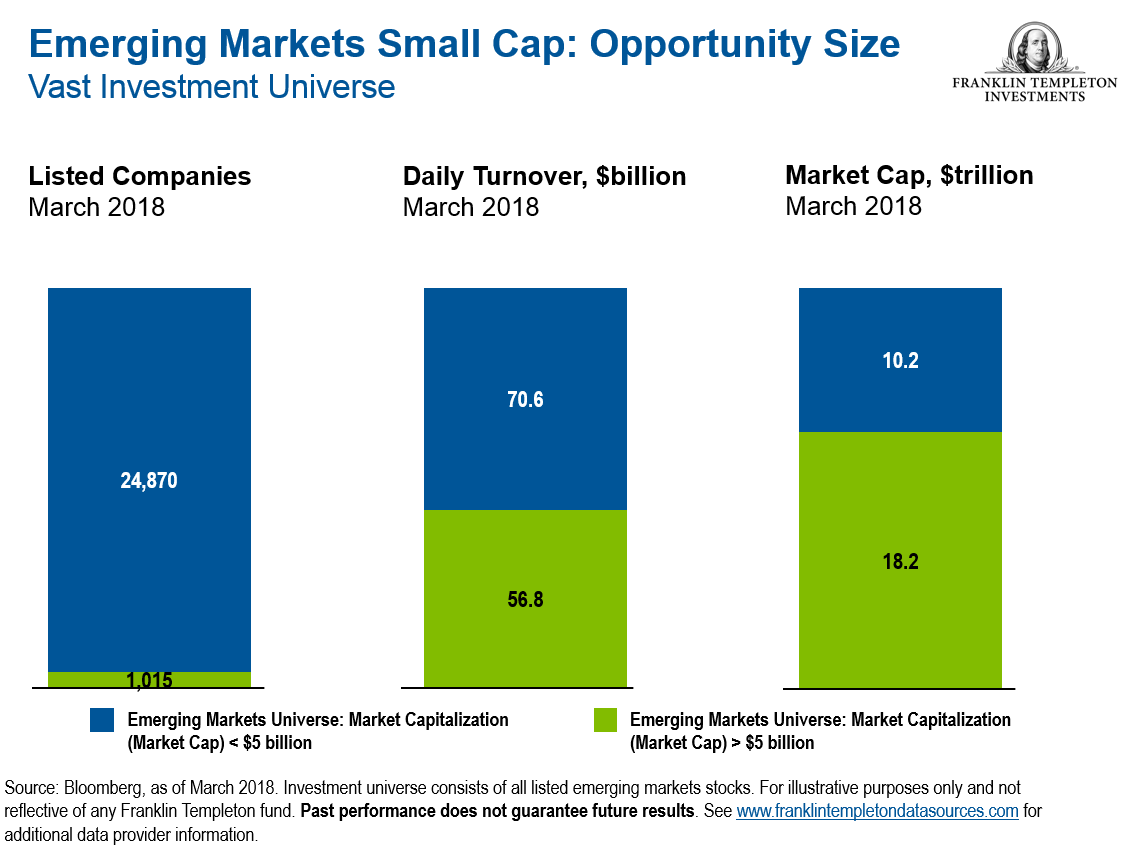
Accordingly, we think the sheer size of the EM small-cap investment universe is a key advantage for active managers, providing abundant opportunities to uncover mispriced companies. EM small caps are typically disproportionately owned by domestic retail investors, who often have a shorter investment horizon than foreign institutional investors and therefore often trade more frequently. This tends to boost liquidity.
A good example of this is India—investors have a vast number of smaller companies to choose from, and the skew of ownership is toward local investors. In addition, disproportionate ownership by local investors can generate non-correlated outperformance that large-cap-focused investors would forego.
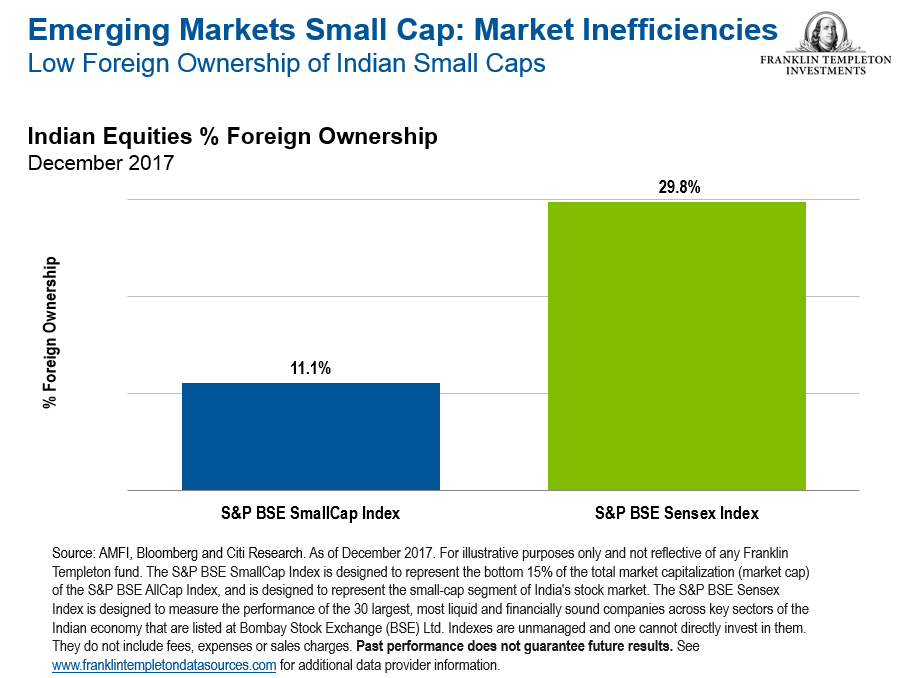
A key difference between developed-market small caps and EM small caps is that EM small caps in many markets are often still significant players in their local markets; a market capitalization of close to US$5 billion could represent a leading company in a certain country, index or sector—perhaps a well-established business with a long and successful track record. Many of these companies are family-owned or controlled, and many are companies with stable profiles when compared with developed-market small caps.
It Is Not Necessarily a More Volatile Investment
Another misconception surrounding investment in EM small caps is that the volatility of these assets is higher than that of their larger-cap counterparts. Like all investments, EM small caps have real and perceived risks. Some of these risks are those associated with the EM equity universe overall, such as higher volatility relative to developed markets.
Although individual stocks can indeed be very volatile, according to our research, the pairwise correlations3 of different EM small-cap companies are generally lower, which we believe is in part due to the expansiveness and diversity of businesses within this investment space. For example, a South Korean television and online shopping stock is not typically impacted by the same factors as an Indian cement stock. This can help reduce risk at the asset class level, and in fact the aggregate volatility of the MSCI EM Small Cap Index is lower than that of the MSCI EM Large Cap for the three- and five-year periods as of March, 31, 2018, which you can see in the chart below.
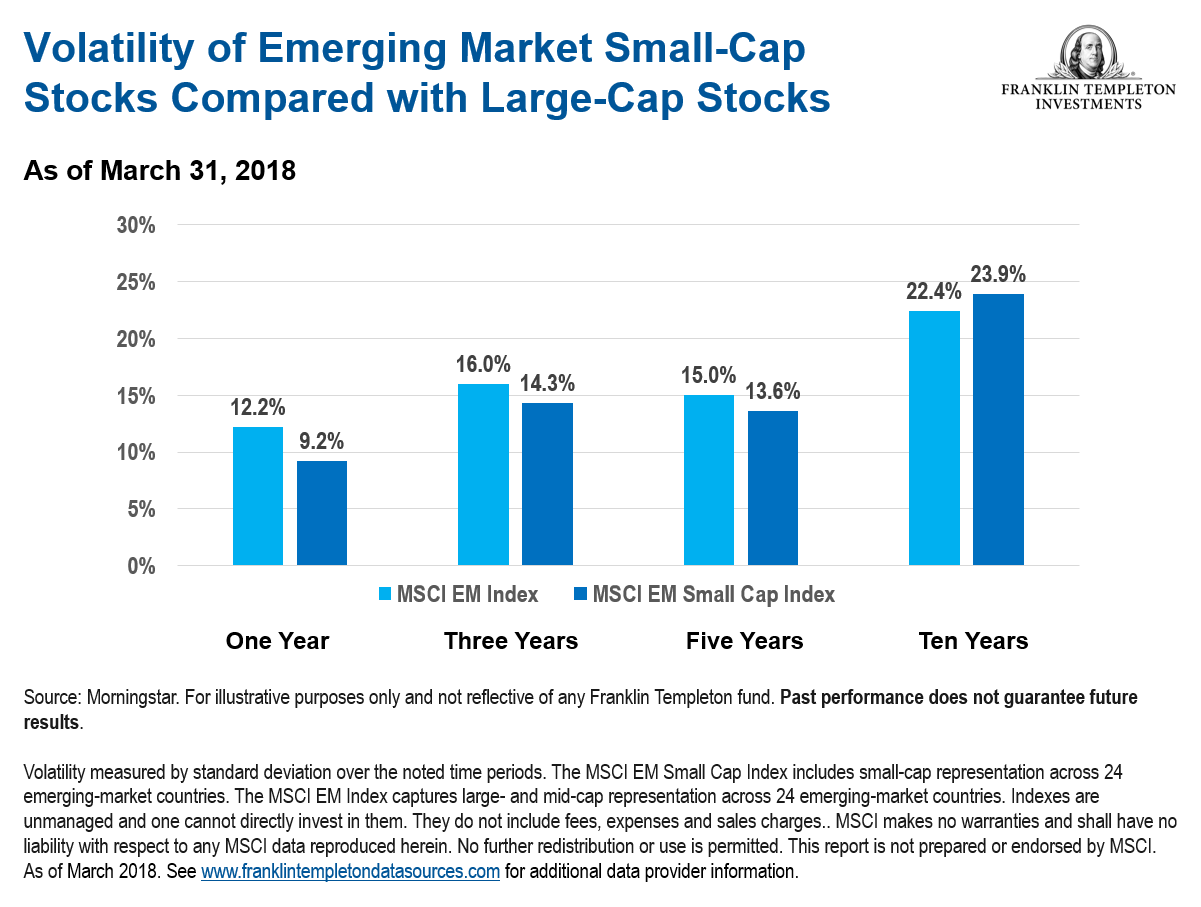
Overlooked and Under-Researched
Not only do many investment managers overlook EM small caps, but the asset class is also notably under-researched by the sell side. This reflects not only the vast number of companies to cover, but also the relative lack of information available. Unsurprisingly, the result is that the average number of stock research recommendations for EM small caps is much lower than for larger-cap stocks. Also, many small-cap stocks have little or no research coverage.
For a large number of EM small-cap stocks outside of the MSCI EM Small Cap Index, research availability is even more limited. We think this can give a critical advantage to an active manager able to directly research such companies; the opportunity of finding a relatively unknown (off-index) EM small-cap stock that is being mispriced is far greater than for a large company with many analysts producing research recommendations on it.
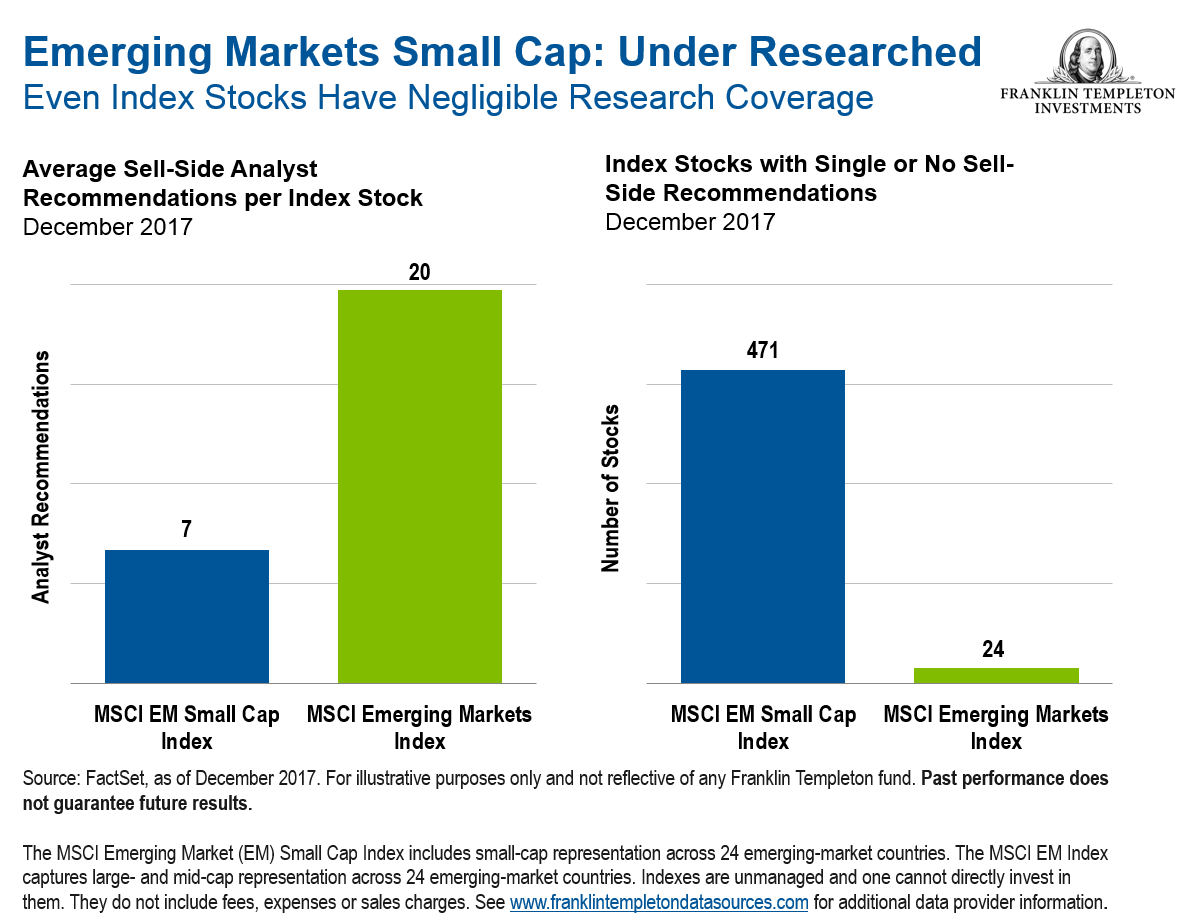
Recapturing Access to Local Exposure to Complement Existing EM Portfolios
Reflecting on the general long-term success of emerging markets, as global economies and as an equity asset class, most of these countries have become ever-more integrated into the world economy. Consequently, their largest and most successful companies have often expanded beyond domestic markets to export and invest globally. Accordingly, domestic factors no longer are the primary drivers of the share prices of many of these stocks. Examples of such companies can include electronics, auto-industry or consumer-related names that derive a substantial portion of their revenues from developed economies rather than those in which they are based.
By contrast, EM small caps generally offer the very exposures that have drawn many investors to emerging markets in the first place, including domestic demand, favorable demographics, local reform initiatives and innovative, niche products.
Consequently, the sectors to which EM small-cap investors are exposed typically differ notably from those of larger-cap stocks. Exposures in information technology and financials disproportionately dominate the MSCI Emerging Markets Index. Global or country-level macroeconomic trends tend to more closely impact these sectors. In addition, state-owned enterprises are often more prevalent among larger-cap stocks. While we find many such state-owned companies to be well managed, the interests of the ultimate owners are not always entirely aligned with those of minority investors.
In contrast, EM small-cap exposures are concentrated in sectors such as consumer discretionary and health care. Often these companies are more locally focused and many are relatively dominant players in smaller industries. The most successful EM small caps will leverage such local strength to expand internationally, supporting their transition into mid- or even large-cap companies over time.
Even within a given sector, economic exposures can differ substantially. For example, in the materials sector, mining companies by their nature are generally large-cap names and are impacted significantly by factors external to their home country, such as global commodity prices.
EM small-cap materials companies likely include businesses with greater exposure to local economic development and demand dynamics. Accordingly, diversifying into EM small caps can provide exposures that may complement an existing larger-cap-oriented EM allocation.
Finding Growth in a Low-Growth World
Emerging markets represent a potential bright spot in a sometimes uncertain world-economic landscape. In January 2018, the International Monetary Fund projected an expansion in global gross domestic product (GDP) growth to 3.9% in 2018.4 As has consistently been the case, the expected growth rate for emerging markets, at 4.9%, sits solidly above the global rate.5 In such an environment, investing in EM small caps may provide exposure to many of the fastest-growing companies in the fastest-growing countries globally.
It is also worth reiterating that topline growth in many smaller companies is typically organic and derived from local market dynamics, rather than being driven by global macroeconomic factors. In addition to organic growth, EM small caps may also see share-price appreciation from being added to an index (thus attracting passive investor flows, and with increased sell-side research attention likely active fund flows also) as well as being potential merger-and-acquisition targets. These are growth drivers that are, to a great extent, independent of macroeconomic considerations.
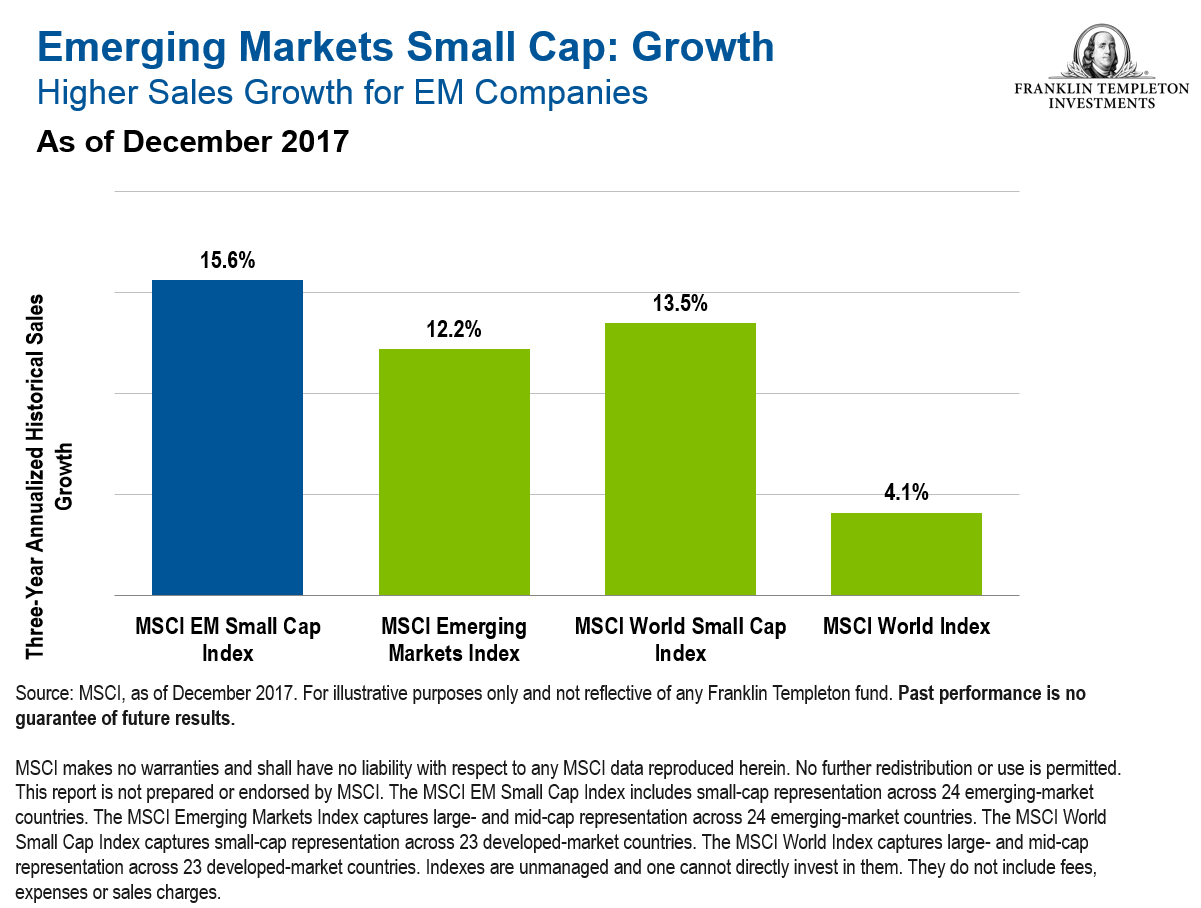
An Active View
As discussed, the MSCI EM Small Cap Index has its own distinct composition, with skews toward the consumer discretionary, materials and industrials sectors. Active managers do not have to follow this skew, if they feel the best stock ideas to add value lie elsewhere, or that these exposures are not appropriate for the current investment climate.
Perhaps what is most important to recognize is that there are numerous EM small-cap companies that will likely remain small, whether due to corporate governance issues, poor quality of management, lack of market growth or other factors. The role of an active manager is to seek to determine which EM small-cap companies will succeed over the long term, with a view to reducing downside risk and thus enhancing risk-adjusted returns.
At Franklin Templeton Emerging Markets Equity, we believe the EM small-cap space is fertile ground for active managers who can focus on risk management and long-term growth drivers for the asset class. Our EM small-cap research is driven by an extensive on-the-ground team of over 80 portfolio managers and analysts in 20 offices globally, which allows us to have regular face-to-face meetings with prospective investments and our investee companies.
Overall, with our bottom-up, high-conviction, long-term investment approach we look to invest in companies with good management teams, where we feel conviction that they can make the right strategic choices.
CFA® and Chartered Financial Analyst® are trademarks owned by CFA Institute.
The comments, opinions and analyses presented herein are for informational purposes only and should not be considered individual investment advice or recommendations to invest in any security or to adopt any investment strategy. Because market and economic conditions are subject to rapid change, comments, opinions and analyses are rendered as of the date of the posting and may change without notice. The material is not intended as a complete analysis of every material fact regarding any country, region, market, industry, investment or strategy.
Important Legal Information
All investments involve risks, including the possible loss of principal. Investments in foreign securities involve special risks including currency fluctuations, economic instability and political developments. Investments in emerging markets, of which frontier markets are a subset, involve heightened risks related to the same factors, in addition to those associated with these markets’ smaller size, lesser liquidity and lack of established legal, political, business and social frameworks to support securities markets. Because these frameworks are typically even less developed in frontier markets, as well as various factors including the increased potential for extreme price volatility, illiquidity, trade barriers and exchange controls, the risks associated with emerging markets are magnified in frontier markets. Stock prices fluctuate, sometimes rapidly and dramatically, due to factors affecting individual companies, particular industries or sectors, or general market conditions. The technology industry can be significantly affected by obsolescence of existing technology, short product cycles, falling prices and profits, competition from new market entrants as well as general economic conditions. Smaller and newer companies can be particularly sensitive to changing economic conditions. Their growth prospects are less certain than those of larger, more established companies, and they can be volatile.
_______________________________________
1. Alpha measures the difference between a fund’s actual returns and its expected returns given its risk level as measured by its beta. A positive alpha figure indicates the fund has performed better than its beta would predict. In contrast, a negative alpha indicates a fund has underperformed, given the expectations established by the fund’s beta. Some investors see alpha as a measurement of the value added or subtracted by a fund’s manager.
2. Sources: Bloomberg, as of March 31, 2018. See www.franklintempletondatasources.com for additional data provider information.
3. Correlation measures the degree to which two investments move in tandem. Correlation will range between 1 (perfect positive correlation where two items have historically moved in the same direction) and -1 (perfect negative correlation, where two items have historically moved in opposite directions).
4. Source: International Monetary Fund, World Economic Outlook, January 2018. There is no assurance that any estimate, forecast or projection will be realized.
5. Ibid.
Related Articles
Center of Gravity of World’s Middle Class Shifts from West to East
India, the world’s second most populous country, could become the world’s largest middle class consumer by 2030, surpassing both China
EM Intelligence Exclusive: Why Emerging Markets Now?
Given the relative importance of emerging markets which account for over 30% of total absolute global equity market capitalization, it
Developments in the Reform of China’s State-Owned Enterprises
Chinese stocks have been soaring in the first half of this year, and I’ve often been asked about whether I

